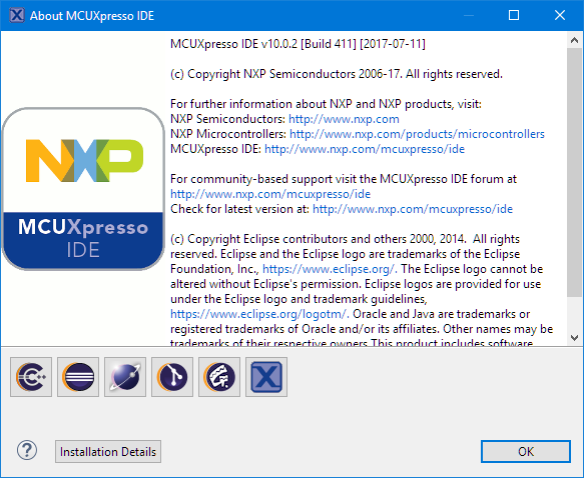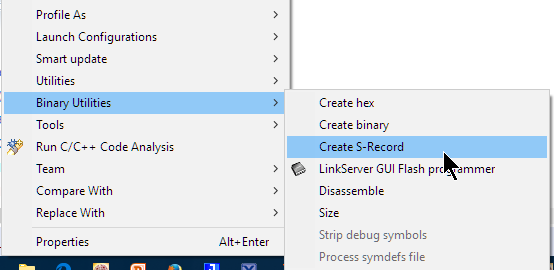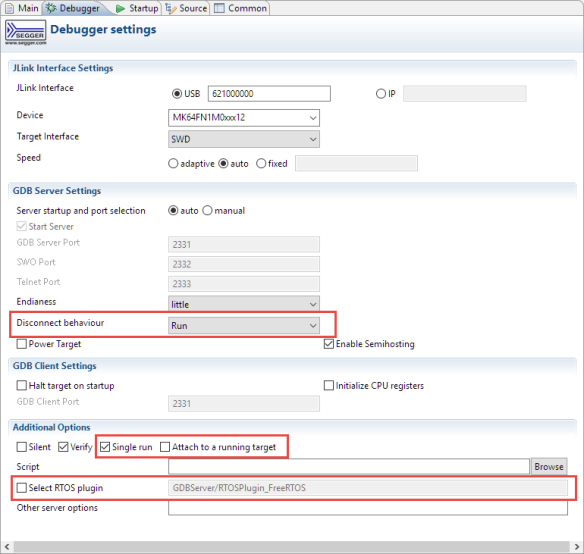NXP has released an updated of their Eclipse based IDE for ARM Cortex-M (Kinetis and LPC) microcontroller: the version v10.0.2 build 411:
MCUXpresso is a code size unlimited, free of charge IDE (Windows, Mac and Linux) from NXP for Kinetis and LPC (ARM Cortex-M) microcontroller devices (see “MCUXpresso IDE: Unified Eclipse IDE for NXPs ARM Cortex-M Microcontrollers“). After the v10.0.0 (build 344) release back in March 2017, there is now the new release v10.0.2 (build 411) available. The release is a full setup/installer which has the advantage I can keep the 10.0.0 installed and install the 10.0.2 side-by-side. As the version number indicates, this is more of a point release and smaller update (see the release notes).
Beside of the smaller changes, the new release comes with several improvements for debugging which makes it worthwhile to download, install and use it.
Binary menu has an option for S19 files (see “MCUXpresso IDE: S-Record, Intel Hex and Binary Files“):
Launch configurations are now shown with a special icon in the project, and I can double-click on a configuration to edit it:
Launching a LinkServer (e.g. using the LPC-Link2 probe) debug session now starts noticeable faster. Same for semihosting with LinkServer: this is faster too.
Other major improvements are for the Segger J-Link.
💡 As noted in the release notes: with all the changes, it is advised to delete and recreate launch configurations (this is done automatically if trying to connect to the board) if moving to the new IDE version.
The IDE setup comes with a new Segger J-Link software, plus new settings to configure the disconnect behaviour, a check box to connect to a running target plus a GUI choice to enable and select the RTOS thread awareness:
Both the P&E and Segger connections now support multiple connections to multiple probes at the same time (concurrent debugging with multiple probes).
And for everyone else who has Kinetis Design Studio installed on Linux: the new IDE now solves a problem with the P&E drivers, so this alone is a good reason for me to update to the new version for my next classes.
Summary
After a little more than 3 months after the first 10.0.0 release, NXP has release an update with the version 10.0.2. The new update shows that NXP is committed to their new combined IDE. 10.0 was already very solid for me. The sum of all the smaller changes and especially the extensions for debugging makes it worth the update, and I’m in the process of moving all my MCUXpresso IDE projects to the new version 10.0.2.
Happy Updating 🙂
Links
- MCUXpresso IDE download page: http://www.nxp.com/mcuxpresso/ide
- MCUXpresso IDE v10.0.2 release notes: https://community.nxp.com/community/mcuxpresso/mcuxpresso-ide/blog/2017/07/13/mcuxpresso-ide-v1002-now-available




It’s taking me a long time to get familiar with the KE18F we want to use, but I’m impressed with the reliability of MCUxpresso. I wish it had all the features of KDS as well.
LikeLike
I’m missing Processor Expert. What other feature are you missing?
LikeLike
Well that extra debug file load for the open sda built in to the tower board is one (maybe that’s missing in KDS too but I only found it now).
Mainly though the different library build I’ve still not figured – on KDS no problem adding my boot code into the project at library build, not sure yet how to do that.
And since it generally is better / more stable, would be nice to move my KE06Z project over from KDS!
LikeLike
Hi Ian,
I’m not sure what you mean with that ‘extra debug file load’? Can you provide details about what you mean?
Erich
LikeLike
Something you helped me with on KDS last year; my checksum is not in the ELF only in my created SREC so checksum fails debug. You showed me to add another ELF to debug launch configuration and specify a SREC with just the checksum. Works perfectly on KDS but on MCUxpresso it’s available in P&E launcher but not in the “free” open sda one.
https://community.nxp.com/thread/453766
LikeLike
Hi Ian,
I see. Keep in mind that P&E is available for the free OpenSDA debug interface too (https://mcuoneclipse.com/2013/12/14/new-pe-opensda-firmware-v114/).
LikeLike
Thanks, but I think that’s reverse of what I’d want! I’d like you use the built-in-tower debug interface, but through the P&E debugger that supports additional ELF file – can’t imagine that would work.
LikeLike
Yes, you can use the built-in tower debug interface (which is actually from P&E I think). You can load Segger, P&E or CMSIS-DAP firmware on it.
LikeLike
Hi,
Did you manage to install Eclipse Marketplace in it?
I can’t and I’m not sure it’s a problem on my side or something else.
LikeLike
Hi Romain,
yes, using http://download.eclipse.org/mpc/releases/1.5.2/ as update site.
Erich
LikeLike
Pingback: Tutorial: Makefile Projects with Eclipse | MCU on Eclipse
Pingback: Tutorial: Makefile Projects with Eclipse | MCU on Eclipse
Hey Erich, Good to see NXP and Freescale finally have a common IDE.
I wish they would have released there OpenSource SDK. where all necessary source code of most if not all devices is present. Also downloading source for FRDM-KL25z tool more than 15 minutes of selection not that I am complaining. I had expected it to be easy download at least after logging in.
But I would like to thank them for so neat source organised in the zip file.
It would be a good idea to have a walk through guild of this source code.
LikeLike
Yes, this is a bit wish from my side too: to have everything (or at least the possibility) or multiple devices in a single SDK. I wrote about combining SDKs here: https://mcuoneclipse.com/2016/06/13/combining-multiple-nxp-kinetis-sdks-into-one/. But this recently did not work any more, it seems that every release for a device has some extensions/changes, and getting it in one directory causes a lot of risks for me.
I know that there were some discussions to have everything in a public Git repository: that way it would be easy to get everything and/or to know that changes from one release to another.
LikeLike
I wish our wish come true in near future. I am pushing my self to do everything using command line Linux. Like your timefirst blinky tutorial on FRDM-kl25z. I have compiled tool chain and tested that blinky code. To my surprise windows make file compiled code and worked when fleshed. Only problem I had with make clean. Del was not present and / & \ issue. Now moving forward to compile freertos from scratch. I had few questions.
1. Your projects are licence under which GPLv2?
2.
LikeLike
In Linux, the command to delete is called remove, with a short form ‘rm’
LikeLike
As David pointed out, you should use ‘rm’ instead of del. Most Windows Eclipse distributions come with a ‘rm’ too to keep make files portable between hosts.
As for the project license: see https://github.com/ErichStyger/mcuoneclipse/blob/master/LICENSE.txt
For the component sources, it is a bit more complex, as coming from different licenses, so check what you are using. The different license texts are posted here: https://github.com/ErichStyger/McuOnEclipse_PEx
LikeLike
Yeah, Done that working great.
Good to know it is Educational LICENCE.
LikeLike
Pingback: Troubleshooting Tips for FreeRTOS Thread Aware Debugging in Eclipse | MCU on Eclipse
Pingback: Tutorial: Porting BLE+NRF Kinetis Design Studio Project to MCUXpresso IDE | MCU on Eclipse
Pingback: Recovering and Updating the NXP OpenSDA Bootloader with P&E Multilink and MCUXpresso IDE | MCU on Eclipse
Pingback: Managing Project and Library Dependencies with Eclipse CDT | MCU on Eclipse
Hi, I’ve a doubt about the use of MCUXpresso.
I installed the SDK downloaded from the MCUXpresso SDK Builder with drag and drop on apposite window, but I don’t understand how to include it on my project. I use SVN and I have all drivers needed in my project but if I compile in another PC without my SDK it return an error.
Do you have an idea?
Thank you very much!
LikeLike
You have to to install that SDK on that other PC too. I hope that this might get relaxed in a future version, but this is how I see it is working now.
You would have to pull that SDK for example on that other machine too.
LikeLike
Pingback: Eclipse MCUXpresso IDE 10.1 with integrated MCUXpresso Configuration Tools | MCU on Eclipse